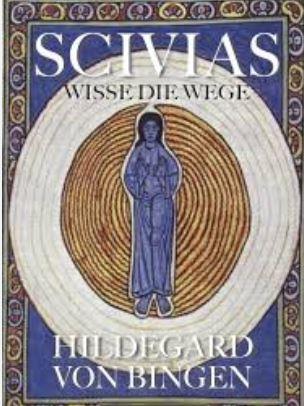Scivias

📖 What is Scivias?
Scivias is a theological and visionary work written by Hildegard of Bingen, a 12th-century Benedictine abbess, mystic, composer, and polymath.
The full Latin title is:
Scivias Domini — "Know the Ways of the Lord"
-
Written between 1141 and 1151.
-
Composed in Latin, consisting of 26 visionary revelations.
-
Combines spiritual visions, theology, cosmic symbolism, and moral instruction.
-
Often accompanied by stunning illuminated illustrations (some possibly designed under her direction).
🌟 Who was Hildegard of Bingen?
-
Born: 1098, in Germany
-
Died: 1179
-
A Christian mystic, visionary, composer, natural scientist, and early feminist icon, honestly.
-
Claimed to have been receiving divine visions from a young age.
-
Was later officially recognized by the Catholic Church as a Doctor of the Church (in 2012!).
Her visions were taken very seriously—even Pope Eugenius III read parts of Scivias and gave his blessing for it to be widely shared.
🔮 What’s in Scivias?
The book is structured into three parts, reflecting a cosmic journey from creation to salvation:
📘 Part 1: The Order of the Cosmos
-
6 visions
-
Describes the nature of God, creation, the fall of humanity.
-
Includes cosmic imagery—like a vision of the soul in the shape of a human form made of fire and light.
📗 Part 2: The Redemption through Christ
-
7 visions
-
Focuses on Christ, the Church, and the sacraments.
-
Includes the famous vision of the Church as a radiant woman, a common symbol in her work.
📕 Part 3: The End Times and the Glory of Heaven
-
13 visions
-
Describes the struggle of the soul, the rise of evil, the Antichrist, and the final redemption.
-
Ends with a vision of the New Heaven and New Earth—a beautiful, luminous image of eternal peace.
🎵 Bonus: Music & Visions
-
Hildegard also composed liturgical music to go along with her visions.
-
Her songs are mystical, soaring, and haunting—think ethereal medieval chants.
-
Her music and visionary art are considered some of the most original expressions of the medieval period.
🧠 Themes in Scivias
-
Divine Light and Feminine Imagery: God often appears as radiant, maternal, and enveloping.
-
Cosmic Unity: Everything is part of a divine order, and sin is a rupture in that harmony.
-
The Soul’s Journey: Deeply focused on spiritual growth, redemption, and aligning with divine will.
-
Prophetic Voice: She doesn’t just describe visions—she interprets and preaches through them.
📜 Why It Still Matters
-
One of the most important mystical texts of the Middle Ages.
-
A rare example of a woman’s theological voice being respected in her time.
-
Influenced later Christian mysticism, feminist theology, and even New Age spiritual writings.
-
Still studied today in religious studies, medieval history, philosophy, and art.

